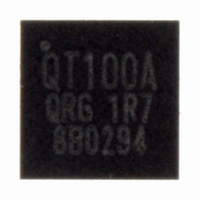QT100A-ISG Atmel, QT100A-ISG Datasheet - Page 4

QT100A-ISG
Manufacturer Part Number
QT100A-ISG
Description
IC SENS TOUCH/PROX 1CHAN 6-WSON
Manufacturer
Atmel
Series
QTouch™r
Type
Touch Sensing Controllerr
Datasheet
1.QT100A-ISG.pdf
(10 pages)
Specifications of QT100A-ISG
Input Type
Logic
Output Type
Logic
Current - Supply
600µA
Mounting Type
Surface Mount
Package / Case
6-WSON
For Use With
427-1128 - KIT EVAL FOR QT100
Lead Free Status / RoHS Status
Lead free / RoHS Compliant
Interface
-
Other names
427-1135-2
2 Operation Specifics
2.1 Run Modes
2.1.1 Introduction
The QT100A has three running modes which depend on the
logic level applied to the SYNC pin.
QT100A
Figure 2.3 Sync Mode (triggered by negative edges on SYNC)
QT100A
QT100A
SYNC
SNSK
SYNC
SYNC
OUT
SNSK
SNSK
QT100A
SYNC
SNSK
SNSK
QT100A
SYNC
Figure 2.4 Sync Mode (Short Pulses)
~85ms
sleep
sleep
sleep
Figure 2.2 Fast Mode Bursts
Figure 2.1 Low Power Mode
~1ms
(SYNC held high)
(SYNC held low)
sleep
sleep
>10us
sleep
>10us
slow mode sleep period
slow mode sleep period
fast detect
integrator
sleep
sleep
>10us
sleep
Revert to
Fast Mode
Revert to
Slow Mode
4
2.1.2 Fast Mode (SYNC = 1)
The QT100A runs in Fast mode if the SYNC pin is
permanently high. In this mode the QT100A runs at
maximum speed at the expense of increased current
consumption. Fast mode is useful when speed of response is
the prime design requirement. The delay between bursts in
Fast mode is approximately 1ms, as shown in Figure 2.2.
2.1.3 Low Power Mode (SYNC = 0)
The QT100A runs in Low Power (LP) mode if the SYNC pin
is held low. In this mode it sleeps for approximately 85ms at
the end of each burst, saving power but slowing response.
On detecting a possible key touch, it temporarily switches to
Fast mode until either the key touch is confirmed or found to
be spurious (via the detect integration process). It then
returns to LP mode after the key touch is resolved as shown
in Figure 2.1.
2.1.4 Sync Mode
It is possible to synchronize the device to an external clock
source by placing an appropriate waveform on the SYNC pin.
Sync mode can synchronize multiple QT100A devices to
each other to prevent cross-interference, or it can be used to
enhance noise immunity from low frequency sources such as
50Hz or 60Hz mains signals.
The Sync pin is sampled at the end of each burst. If the
device is in Fast mode and the Sync pin is sampled high,
then the device continues to operate in Fast mode (Figure
2.2). If SYNC is sampled low, then the device goes to sleep.
From then on, it will operate in Sync mode (Figure 2.1).
Therefore, to guarantee entry into Sync mode the low period
of the Sync signal should be longer than the burst length
(Figure 2.3).
However, once Sync mode has been entered, if the Sync
signal consists of a series of short pulses (>10µs) then a
burst will only occur on the falling edge of each pulse
(Figure2.4).
In Sync mode, the device will sleep after each measurement
burst (just as in LP mode) but will be awakened by the falling
edge of the Sync signal, resulting in a new measurement
burst. If Sync remains unchanged for a period longer than
the LP mode sleep period (about 85ms), the device will
resume operation in either Fast or LP mode depending on
the level of the Sync pin (Figure 2.3).
There is no DI in Sync mode (each touch is a detection) but
the Max On-duration will depend on the time between Sync
pulses; see Sections 2.3 and 2.4. Recalibration timeout is a
fixed number of measurements so will vary with the Sync
period.
2.2 Threshold
The internal signal threshold level is fixed at 13 counts of
change with respect to the internal reference level, which in
turn adjusts itself slowly in accordance with the drift
compensation mechanism.
The QT100A employs a hysteresis dropout of 3 counts of the
delta between the reference and threshold levels.
2.3 Max On-duration
If an object or material obstructs the sense pad the signal
may rise enough to create a detection, preventing further
operation. To prevent this, the sensor includes a timer which
monitors detections. If a detection exceeds the timer setting
the sensor performs a full recalibration. This is known as the
C opyright © 2008 QRG Ltd.
QT100A_1R7.01_0308












